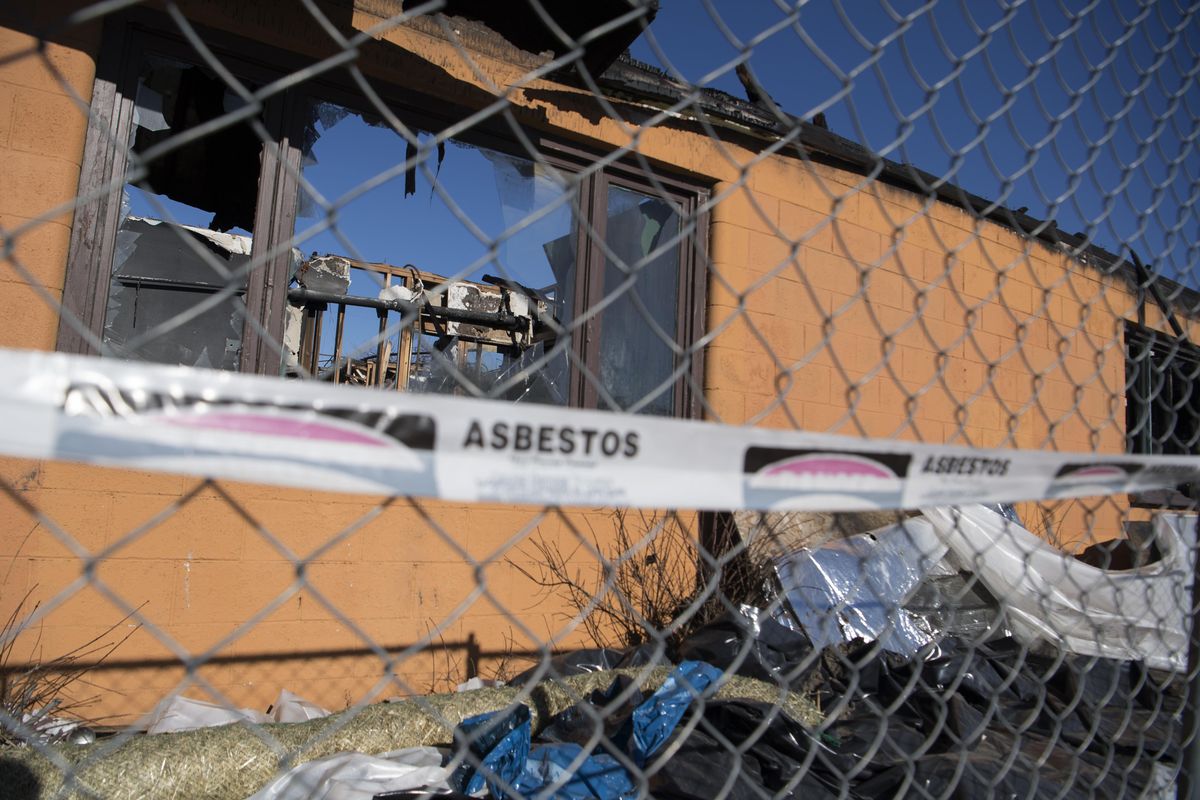Spokane may have to pay $330,000 to demolish burned out Hillyard building that likely has asbestos

The charred husk of a former church and substance abuse treatment center in the Hillyard neighborhood could leave city taxpayers footing a $330,000 bill.
That’s the initial estimate of how much it will cost to demolish the building at 3011 E. Wellesley Ave., which was lined with vermiculite insulation believed to contain cancer-causing asbestos. The building’s owner, Ivan Kriger, has not submitted a plan to tear down the structure despite an order to do so, though the city has recently begun talks with him to cover the demolition. The single-story structure originally built in 1906 caught fire in November shortly after Kriger purchased the property from Victory Outreach Spokane.
Kriger said Monday he’s working through his insurance company to cover the cost of cleanup and declined to comment further.
The city’s code enforcement team has approached the Spokane City Council about covering the cost of the ordered demolition if a deal is not reached with Kriger. Building and planning officials are currently investigating options that wouldn’t involve pulling the money out of the general fund, which is supported by taxes, said Heather Trautman, the city’s director of code enforcement.
“If there’s an order for a building to be demolished due to structural damage, the property owner is always given an opportunity and a timeline to do that,” said Trautman. “When the property owner fails to do so, the city doesn’t have any option in these situations.”
The building had already been slated for demolition by the city’s building official before Kriger bought it, according to city records. A new demolition order was issued after the fire, which expired on Christmas Day without any filed plans or permits from Kriger, according to city officials.
The blaze, extinguished by Spokane firefighters in the early morning hours of Nov. 7, released vermiculite into an alley adjacent to the building and the surrounding sidewalk. The Spokane Transit Authority moved its bus stop at the corner of Wellesley Avenue and Haven Street a half block to the west because of the contamination.
The city already has spent $35,000 to clean up the vermiculite released directly after the fire, Trautman said. Code enforcement also is paying to rent fencing to prevent unauthorized access to the building.
An investigation into the cause of the fire is ongoing, said Michelle Anderson, a spokeswoman for the city’s police and fire departments.
Dave Griswold, president of the planning group Hillyard Community Futures, said he’s known Kriger for 10 years and anticipates the developer will work with the city to resolve the demolition issue.
“Ivan has always been responsible for everything he’s taken on,” Griswold said.
Kriger partnered with Stephen Antonietti to make a bid for the historic downtown Ridpath Hotel in 2015. Ron Wells eventually made a deal to purchase the condominiums in the building and is moving forward with plans to renovate the hotel into affordable apartments scheduled to open later this year.
Spokane Regional Clean Air Agency officials were contacted by the city to assist with the cleanup process. The agency treats all vermiculite, a mineral commonly used in insulation, as containing asbestos. Asbestos is a known carcinogen that is dangerous if inhaled, and various products containing asbestos have been banned by the Environmental Protection Agency.
The agency still is cleaning up asbestos in the city of Libby, Montana, where a vermiculite product known as Zonolite was manufactured for several decades and wound up in many homes throughout the region, said Lori Rodriguez, manager of compliance for the clean air agency.
“We treat vermiculite as though it was asbestos, knowing that it was likely contaminated,” she said.
The presence of asbestos has driven up the anticipated cost of demolition, as the vermiculite inside the walls will need to be treated on-site to prevent further contamination.
“We don’t want people traipsing through it,” said Lisa Woodard, a clean air agency spokeswoman. “There is a potential, should we have a lot of wind, that material would be released.”
Pedro Ibarra has rented a single-story home at Haven Street and Broad Avenue, just to the north of Kriger’s fenced-off property, for the past several years, he said. When the wind kicks up, the property can smell like burning wood or plastic, he said.
“The city needs to do something quickly,” Ibarra said last week.
It’s unclear what will happen to a painted mural on the former church’s east-facing wall, which depicts James Hill, the railroad executive whose flight to avoid Spokane’s business taxes led to the formation of the Hill’s Yard neighborhood in the late 1800s. The mural was painted in 1994 by Tom Quinn, whose work can be seen on other walls throughout Spokane. The work was sponsored by the Greater Hillyard Business Association.
Quinn said Tuesday that he was unaware that the building might be torn down, but that he doesn’t have a problem if the art is demolished.
Griswold said the art may be salvageable, because it’s painted on a part of the building that wasn’t touched by the flames. But Trautman said that decision would have to be made by safety inspectors and the contractor selected to complete the demolition work.
The city requested additional bids for the demolition work Tuesday, and will know in 10 days whether the initial price tag can be reduced. In the meantime, the city will work with Kriger to develop an alternative plan, Trautman said, but the building must be razed, and it could require public money to do so.
“The city still has to act in the public’s best interest,” Trautman said.